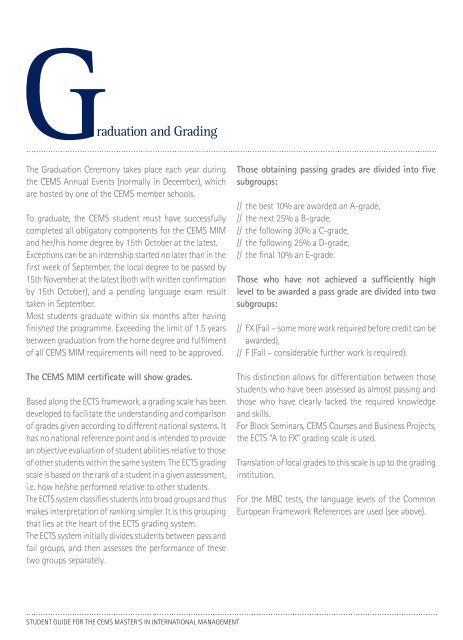You also want an ePaper? Increase the reach of your titles
YUMPU automatically turns print PDFs into web optimized ePapers that Google loves.
G raduation and GradingThe Graduation Ceremony takes place each year duringthe <strong>CEMS</strong> Annual Events (normally in December), whichare hosted by one of the <strong>CEMS</strong> member schools.To graduate, the <strong>CEMS</strong> student must have successfullycompleted all obligatory components for the <strong>CEMS</strong> <strong>MIM</strong>and her/his home degree by 15th October at the latest.Exceptions can be an internship started no later than in thefirst week of September, the local degree to be passed by15th November at the latest (both with written confirmationby 15th October), and a pending language exam resulttaken in September.Most students graduate within six months after havingfinished the programme. Exceeding the limit of 1.5 yearsbetween graduation from the home degree and fulfilmentof all <strong>CEMS</strong> <strong>MIM</strong> requirements will need to be approved.The <strong>CEMS</strong> <strong>MIM</strong> certificate will show grades.Based along the ECTS framework, a grading scale has beendeveloped to facilitate the understanding and comparisonof grades given according to different national systems. Ithas no national reference point and is intended to providean objective evaluation of student abilities relative to thoseof other students within the same system. The ECTS gradingscale is based on the rank of a student in a given assessment,i.e. how he/she performed relative to other students.The ECTS system classifies students into broad groups and thusmakes interpretation of ranking simpler. It is this groupingthat lies at the heart of the ECTS grading system.The ECTS system initially divides students between pass andfail groups, and then assesses the performance of thesetwo groups separately.Those obtaining passing grades are divided into fivesubgroups:// the best 10% are awarded an A-grade,// the next 25% a B-grade,// the following 30% a C-grade,// the following 25% a D-grade,// the final 10% an E-grade.Those who have not achieved a sufficiently highlevel to be awarded a pass grade are divided into twosubgroups:// FX (Fail – some more work required before credit can beawarded),// F (Fail – considerable further work is required).This distinction allows for differentiation between thosestudents who have been assessed as almost passing andthose who have clearly lacked the required knowledgeand skills.For Block Seminars, <strong>CEMS</strong> Courses and Business Projects,the ECTS “A to FX” grading scale is used.Translation of local grades to this scale is up to the gradinginstitution.For the MBC tests, the language levels of the CommonEuropean Framework References are used (see above).STUDENT GUIDE FOR THE <strong>CEMS</strong> MASTER’S IN INTERNATIONAL MANAGEMENT


